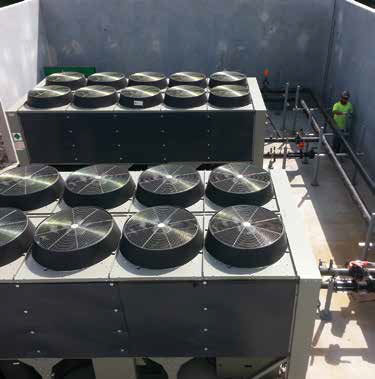Every chiller works according to the same basic principles, utilizing compressors, pumps, condensers and evaporators to achieve cooling. Chillers are mainly classified by the way the condenser is cooled, normally the unit is air-cooled or the unit is water-cooled. In the end, air-cooled and water-cooled chillers achieve the same goal.
Water-cooled or air-cooled chillers all operate on basically the same principle: utilizing compressors, pumps, condensers and evaporators to achieve cooling.
Water-Cooled vs. Air-Cooled.
Selecting the right equipment, no matter what project it is for, can be difficult, and chillers are no exception. Professionals used to believe that water-cooled chillers were the more efficient of the two types of chillers available, but more recently, the thinking has changed. Aircooled chiller systems have a much lower installation cost and a lower overall cost of maintenance when compared to water-cooled chiller systems.
Within a water-cooled chiller system, a cooling tower is also necessary to help chill the water that is cooling the chiller fluid and releases excess heat into the atmosphere. If the cooling tower cost is added onto the initial cost of the water-cooled chiller it can prove to be twice as expensive, in some situations, as an air-cooled chiller system.
Protecting the Ozone: What you should know about refrigerants.
In 1987, the Montreal Protocol, an international environmental agreement, established requirements that began the worldwide phase-out of ozone-depleting CFCs (chlorofluorocarbons). These requirements were later modified, leading to the phase-out in 1996 of CFC production in all developed nations. In 1992, the Montreal Protocol was amended to establish a schedule for the phase-out of HCFCs (hydrochlorofluorocarbons). HCFCs – the type of coolant used in commercial chillers – are less damaging to the ozone layer than CFCs, but still contain ozonedestroying chlorine. The Montreal Protocol as amended is carried out in the U.S. through Title VI of the Clean Air Act, which is implemented by the EPA.
HCFC-22 (also known as R-22) had been the refrigerant of choice for residential heat pump and air-conditioning systems for more than four decades. Unfortunately for the environment, releases of R-22, such as those from leaks, contribute to ozone depletion. Any chiller built before the year 2010 that utilizes type R-22 coolant is still allowed to be used in production, but R-22 coolant is slowly being phased out and these units will become obsolete by the year 2022.
As the manufacture and use of R-22 is phased out over the coming years as part of the agreement to end production of HCFCs, manufacturers of air conditioning systems and chillers are offering equipment that uses ozone-friendly refrigerants. The good news for users of commercial chillers is that there are many other types of coolants such as R-134a, R-507 or even R-404a.
Brand-neutral. There are many different manufacturers for chillers. Some have become more popular for one reason or another, whether it is for size, type of system or coolant. From our sales experience, we have found that there is little brand preference toward one specific brand of chiller; instead sizing, is the most important factor in decision-making.
Some of the smaller brands of chillers include Applied Engineering Company (AEC), Conair and Budzar. Some of the larger units include Carrier, York, Trane and FES. There is no specific reason for the way chiller sales have evolved over the years as buyers are not too picky when it comes to brand.
This is a brief recap of a presentation on surplus equipment made at the 80th Investment Recovery Association Seminar & Trade Show in April 2014. Additional information provided by the U.S. Environmental Protection Agency and Wikipedia. –Gregg Epstein, President, Perry Videx, LLC gepstein@perryvidex.com 609.288.4030
VOL. 4, 2014





